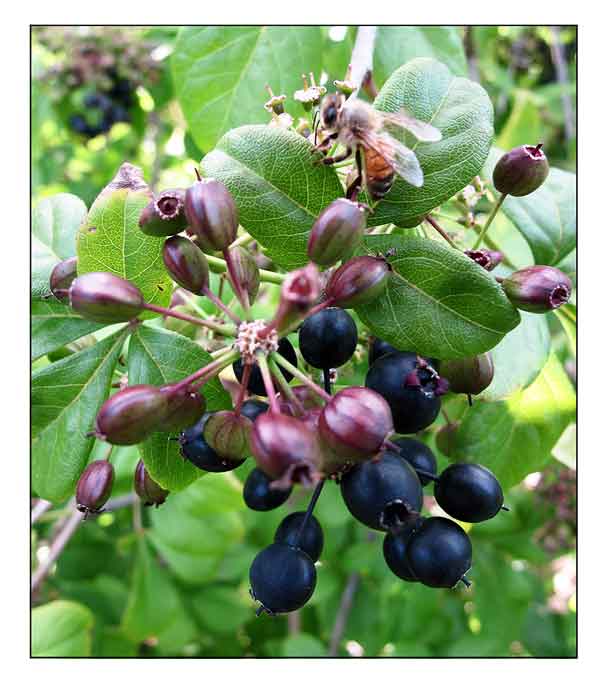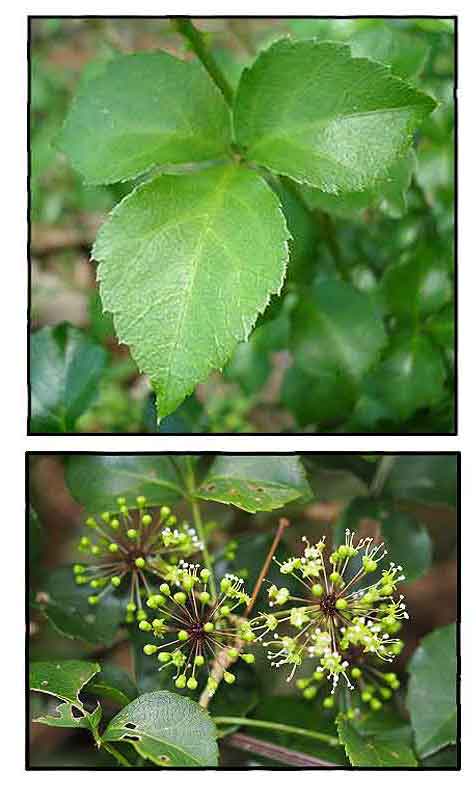 Gen info Gen info
- Eleutherococcus is a genus of 38 species of thorny shrubs and trees in the family Araliaceae.
- Genus name Acanthopanax means "thorny ginseng". Eleutherococcus derives from Greek, meaning "free-berried."
Botany
Eleutherococcus trifoliatus is a shrub, scandent or climber, to 7 m tall. Branches with scattered, recurved prickles. Petiole 2-6 cm, glabrous, prickly; petiolules 2-8 mm; leaflets 3(-5), ovate, elliptic-ovate, or oblong, 4-10 × 2-4.5 cm, papery, adaxially glabrous or slightly setose on midvein and veins, secondary veins 5 or 6 pairs, base cuneate, margin serrulate, apex acute or acuminate. Inflorescence a terminal raceme of umbels or a compound umbel, borne on leafy shoots, with 3-10 umbels; peduncles 2-7 cm; pedicels 1-2 cm. Calyx with 5 teeth, glabrous. Ovary 2-carpellate; styles united to middle. Fruit globose, laterally compressed, 3-4 mm; style bifid, ca. 1.5 mm. (Flora of China)
Distribution
- Native to the Philippines.
- Also native to Assam, China, Myanmar, Nepal, Taiwan, Thailand, Vietnam. (1)
 Constituents Constituents
- Proximate composition of leaves per 100g DW yields 20.67 g, vitamin C 82.88 mg, carotene 134 mg, fiber 56.94 g, Fe 11.60 mg, calcium 356.91 mg. (4)
- Ethanol extract of Acanthopanax trifoliatus yielded chlorogenic acid, isochlorogenic acid A, isochlorogenic acid C, and rutins as major components. (see study below) (6)
- Study of petroleum ether and ethyl acetate fractions from Acanthopanax trifoliatus yielded two new ursane-type triterpenoids, acantrifoic acid C (1) and acantrifoic acid D (2), along with five known triterpenoids (3–7) and eight known diterpenoids (8–15). (see study below) (12)
- Study of Acanthopanax trifoliatus for essential oil yielded more than 60 compounds, representing 97.4% of total amount identified. Main components were
α-pinene (23.9%), sabinene (14.9%), terpinen-4-ol (9.0%), ß-pinene (7.7%), and p-cymene (5.8%). Carissone, an eudesmane derivative, was a minor component. (15)
Properties
- Studies have suggested antioxidant, anti-inflammatory, anticancer, analgesic, hemostatic, antibacterial, anticancer properties.
Parts used
Leaves, root bark, stems.
Uses
Edibility
- Young leaves are edible; blanched in water to remove the bitter principles, then stir fried; also dried and boiled in soups.
- In southern China, young leaves and shoots consumed as vegetable and herbal tea.
Folkloric
- No recorded folkloric medicinal use in the Philippines.
- In Vietnam, used medicinally as a substitute for ginseng.
(2)
- Decoction of root bark and stem used for treatment of lumbago, rheumatism, ostealgia, and impotence.
(2)
- Used to treat hypertension, arthritis, and inflammation.
- Bark used as stimulant and tonic and to improve memory.
- In traditional Chinese medicine, used to increase energy; attributes considered akin to true ginseng.
- In China, root-bark use for stone, wind-heat type of common cold, dampness-heat in the lower jaw, dysentery.
(8)
- In India, decoction of dried bark drunk to treat coughs and colds; used to improve memory.
- Plant used to treat leprosy; roots used to treat ulcers and ringworm infections; decoction of leaves drunk to treat tuberculosis and treat general weakness. In Cambodia, Laos, and Vietnam, bark infusion drunk to correct nervous affections. (14)
Others
- Binding: In northern Luzon, stems used for binding and fencing.
Studies
• Antioxidant / Anti-Inflammatory / Stems and Leaves: Study evaluated the antioxidant and anti-inflammatory activities of ethanol extract of Acanthopanax trifoliatus. LPS-induced NO production in RAW 264.7 cells was significantly decreased (p<0.05) after extract treatment. In vivo studies showed the ethanol extract possessed more activity than chlorogenic acid per mg of dry weight for inhibition of TPA-induced ear edema. TPA-induced increases in cytokine production (TNF-α, IL-6, MMP-9, and TIMP-1) were significantly (p<0.05) reduced by extract treatment. Anti-inflammatory activities was attributed, at least in part, to chlorogenic acid. (see constituents above) (6)
• Antibacterial / Anti-Inflammatory / Analgesic / Hemostatic: Study evaluated the biologic activities of various extracts of A. trifoliatus. The petroleum ether extract exhibited highest antibacterial effect. Ethyl acetate extract yielded highest substance content, with strong hemostatic and analgesic activities. Chlorform extract showed stronger anti-inflammatory effect and significantly reduced IL-1ß protein expression. The EA extract showed highest polyphenol and flavonoid content, including rutin, chlorogenic acid, isoclorogenic acid A, and isochlorogenic acid C, which may contribute to its nutritional activities. (7)
• Antioxidant / Leaves: Study evaluated the antioxidant activity of various extracts of parts of Acanthopanax trifoliatus. The leaf decoction showed stronger antioxidant capacity by DPPH and TBARS method. Total phenolic and flavonoid contents of extracts ranged from 2.16 to 21.79 g% chlorogenic acid equivalent and from 0.37 to 9.61 g% rutin equivalent, respectively. Results showed the leaf aqueous extract showed highest antioxidant activity and high levels of both phenolic and flavonoid compounds, which correlated with the magnitude of antioxidant activity. (9)
• Anti-Inflammatory / Anti-Hyperalgesic / Leaves: Study evaluated the anti-inflammatory and anti-hyperalgesic effects of various fractions of ethanol extract of Acanthopanax trifoliatus leaves in rats. A methanolic fraction showed most potent activity. In carrageenan-induced edema on rat paw, the methanolic fraction showed 77.24% inhibition at 500 mg/kg dose. On anti-hyperalgesic activity using carrageenan-evoked thermal hyperalgesic on plantar test, the fraction showed highest efficacy at 375 mg. Activities may be due to possible composition of polar compounds, flavonoids and phenolics. (10)
• Anti-Inflammatory / Inhibition of LPS-Induced Expression of iNOS and COX2 / Stems: Study evaluated the effects of dichlormethane extract of stems of Acanthopanax trifoliatus (ATSDC) on inflammatory response and molecular mechanisms underpinning the effect on LPS-stimulated RAW264.7 cells. ATSDC effectively inhibited NO production in LPS-stimulated cells and significantly reduced the production of pro-inflammatory cytokines IL-6 at dose of 40 µg/mL, whereas TNF-α production decreased. The inhibition of iNOS and COX-2 protein expression was significant and dose-dependent. Results suggest potential for use in treatment of inflammatory related diseases. (11)
• Anticancer / Terpenoids: Petroleum ether and ethyl acetate fractions of Acanthopanax trifoliatus showed significant inhibitory effects against SF-268, MCF-7, HepG2, and NCI-H460 cancer cells. The two fractions yielded two new ursane-type triterpenoids, acantrifoic acid C (1) and acantrifoic acid D (2), along with five known triterpenoids (3–7) and eight known diterpenoids (8–15). Compounds 3, 5, and 8 from the ethyl acetate fraction showed strongest inhibitory effects against cancer cells, while 12 and 132 from the petroleum ether extract showed moderate activities. (12)
Availability
Wild-crafted.
|

![]()





